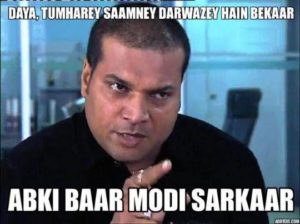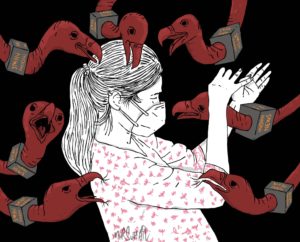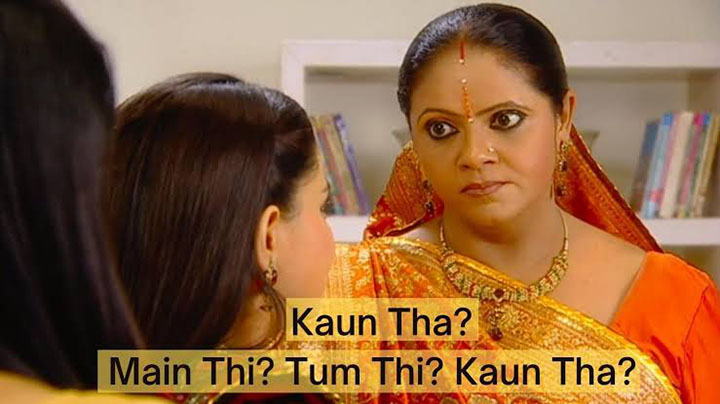Apart from caricaturing public figures, memes appropriated for political propaganda have not really added gravitas to public debates. Rather, they have trivialised serious issues
If we look at some famous “meme” of the last few weeks that grabbed a lot of attention on social media — one was “Rasode me kaun tha (Who was in the kitchen”), a meme from a tv soap where a mother-in-law is inquiring who put an empty pressure cooker on the stove. It would obviously be a daughter-in-law.This became a topic of national discussion for the last few weeks along with a few other including Binod memes. Many adopted it for political messages like “Cooker mein J&K ka Development thha, Rasode me kaun tha“.
BJP spokesperson Sambit Patra, who himself has been the subject of various memes on many occasions, interestingly compared Congress president Rahul Gandhi with the fraudulent daughter-in-law on a tv news debate show.
Though this meme had no direct political appeal, it was appropriated, as has been done with other such non-political memes, to give it a political meaning and shared widely.
Memes are “the agents of chaos and mockery” says journalist Ben Schreckinger in an article because they often are humorous and act on most occasions as just “trolling”. Limor Shifman defines a meme as “cultural information that passes along from person to person, yet gradually scales into a shared social phenomenon.” Their ability to influence the “internet public” is well known.

Therefore, memes are widely used to share a political message. Recently, an illustration by editorial cartoonist Mir Suhail went viral — actress Rhea was surrounded by vulture-like mikes that are biting her. Many dissenting voices like Prashant Bhushan to Rana Ayub shared it. Since every shareable cultural unit on the internet can be classified as a meme, this one can also be called a meme because it is not appearing on the editorial page of a newspaper with proper meaningful context.
So the question arises, is the meme a problem of the media industry or it is an appealing provocation for a political discussion? No, more than a subtle and piercing attack on the media, this meme does not have anything else to offer. If you check the comment section on this meme where the creator shared it, there are mostly counter-memes trolling him or supporting memes and few related/unrelated random thoughts.
Similarly, memes made on news anchor Arnab Goswami are an interesting periodic subject for some meme creators: people mock him and that, contrarily enough, is the base of his popularity. These memes do not do anything except for amusing the “internet public.”
Memes on Arnab like “Mujhe drug do” or clips of him screaming are merely comical, that’s why people are hungry for his cringeworthy content. But earlier his serious punchline “Nation wants to know” had quite served as a memetic “lingua franca” of political and cultural messages, which although comical had a value of some sort of seriousness, which his new “Poochta hai Bharat”, the Hindi translation, of the same doesn’t match.
Do these culture units have an ability to generate healthy political discussion or do they merely destroy it?
In the last few years, various channels on social media like Official PeeingHuman, Kroordashan mocking right-wing tv media have emerged. Not just that, various other left-liberal Facebook and Twitter pages like Rofl Gandhi 2.0, Unofficial Subramanian Swamy have also come to light. These are as vocal about political issues by their memes on BJP, as right-wing pages — for instance those memes blaming first PM Nehru for all current political problems (with a sarcastic undertone). These pages came as counter to well-sustained right-wing trolling on social media and also to counter right-wing propaganda pages like The Frustrated Indian and various others.
Slowly, the ping-pong war of memes to disseminate propaganda is determining political discussion, which unfortunately degrades political discussion. It gets reduced to whataboutery, personal jokes, lewd and insensitive comments.
Jaron Rowan, a cultural research writes in an essay on memes,
“Memes do not produce institutions or political structures nor do they articulate a clear view of a current issue. In contrast, they hover above and raise private conversations to public debates. The humour that characterises them helps members of disaggregated communities to recognise and detect their peers.”

So what do the memes do? Rowan further tells us that memes allow trolls living inside every one of us to find expression. That manifested when Prashant Bhushan got punishment to pay one rupee in a contempt of court case, many unwittingly shared memes mocking even the apex court on that issue.
Memes have power to politicise even a benign incident. For instance, the recent video shared by PM Modi in which he is feeding a peacock. This video gave an opportunity to his opponents to unleash a meme attack on him. But does that lead to an informed debate around any issue that country is facing? If you check those posts on Twitter, Facebook, Instagram, you would find that very few people are engaging in a political discussion, most would share either a counter or supporting meme to mock.
Now, let’s look back to the 2014 election when the slogan “Abki baar Modi sarkar” (Let’s elect the Modi government this time) had wide currency. Every problem that has any “political value” was addressed through memes from corruption to crime against women. Another meme template “Janta maaf nahi karegi” was also used as an organised way of engaging the public.
Memes on the IQ of Rahul Gandhi were some of the most popular during the 2014 elections. Though there is no study proving how much a role memes play in determining the election outcome, but these memes must have damaged Rahul Gandhi’s image. The humorous and pithy way to attack his dynastic lineage and IQ had a lot of takers.
Similarly, the “Feku” image (one who makes false, big promises) is the most accepted form of political memes attacking the PM; there aren’t many around his policies.
Far from triggering informed discourse, memes seem to hide the harshest truths behind humour: when GDP is contracting, India has become the worst affected country by Covid pandemic, memes are making the situation seem tolerable instead of awakening anger and concern.





